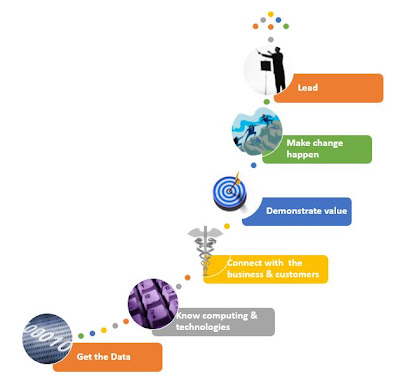To borrow a phrase from Pogo, “We have met
the enemy and he is us.” Those of us practicing
analytics must change the ways we do our job.
Quite frankly, there are huge opportunities to improve healthcare and many
analytics solutions to support it, but we
are only scratching the surface of our potential. We need to expand the scope of our work
from doing things with data to using data to change the organization for the
better, as depicted below.
But this is an overwhelming list of
functions and competencies. No one
person can do it all. It requires a
village (team) to have all the skills and accomplish all the functions. Some suggest that a new chief is needed to
lead us.
Salvation
from the CAO
CAO stands for Chief Analytics
Officer. (It also stands for Chief
Administrative Officer.) The role is
new for the C-suite. Michael Bloomberg,
the data-driven mayor of New York City, in his last State of the City Address,
appointed the city’s first ever CAO, Michael Flowers, to “improve the way all
agencies share information and to make the data available to the public so that
the community can hold the city accountable.”
Flowers used to be the city’s Analytics Director. It’s not clear why there was a title change. The job description sounds better in the
previous job. “Mr. Flowers leads a team
of data scientists in analyzing city data from over 20 city agencies to
allocate its resources quickly and efficiently to prevent fire, crime, safety
hazards, and unhealthy conditions.”
Chiefs are becoming very popular. Forbes lists new C-suite titles including Chief Internet Evangelist, Chief Happiness Officer, Chief Privacy
Officer, Chief Digital Officer, Chief Knowledge Officer and Chief Customer
Officer among others. In healthcare, the
new CAO role joins forces with other information leaders including the CIO
(information), CDO (data), CIO (innovation), CMIO (medical informatics), and
CNIO (nursing informatics). I bet there
are more to come.
I guess the reason for chiefs is to
bring visibility to the function, get the ear of the CEO, collaborate with peer
chiefs for the good of the enterprise, provide better management oversight, and
be accountable for results. All good
things and it’s important that analytics is recognized as an important function
along with the dozens of others. And it
is good to have the executive talent.
But, leadership is not just for the few chiefs. It’s for all of us.
Remake
ourselves
Mahatma Ghandi said “Be the change that
you wish to see in the world.” We need
to expand our technical and people skills to increase the utility of analytics
in healthcare. We need to work locally
and make teams work better through communications and collaboration and
dedication to a common goal. We need to focus
on the immediate tasks at hand such as working through an algorithm or building
a database and also be sure there is a receptor site to absorb our work. We need to visualize how analytics improves
business and society. We need to lead
by our own example.
This blog is an abstract from my
chapter, Health Analytics: The Way Forward in the forthcoming book I
am editing, Analytics in Healthcare and the Life Sciences: Strategies,Implementation Methods, and Best Practices, to be published in December 2013.

No comments:
Post a Comment